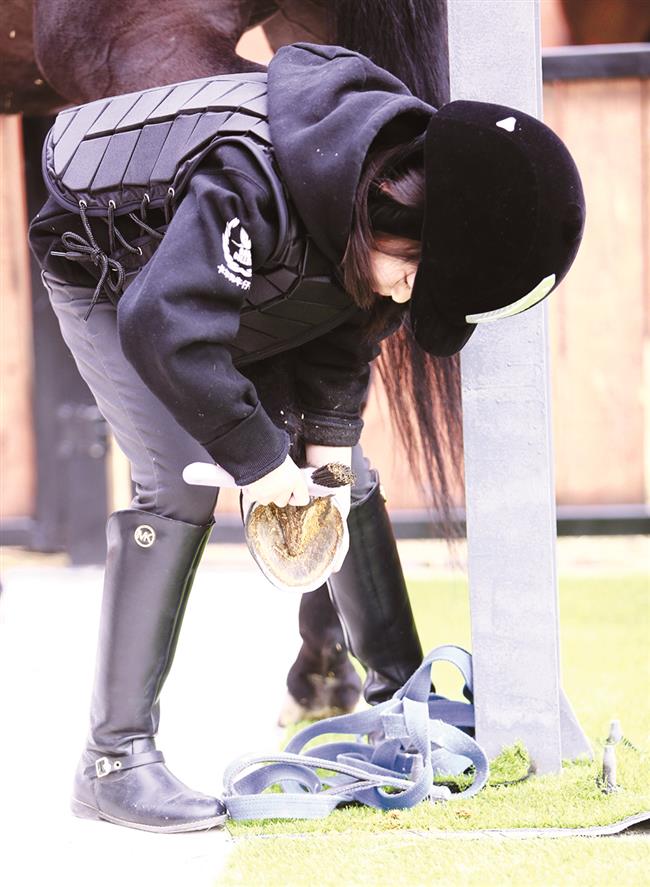Young riders sit tall in the saddle

A boy rides a horse under the instruction of his coach.
For many long-suffering Chinese kids, weekends are a tedious time of unwelcome extra lessons, but not for 12-year-old Shao Siyuan: Her weekends are spent in a dream world of ponies.
She arrives at least an hour before her riding lesson at the Pony International Youth Cavaliers Academy in Minhang District to feed the horses.
“I like horses so much. They are usually quite docile animals, though sometimes big horses will bully smaller ones,” said Shao.
Shao has been taking riding lessons for a year and a half, ever since she took a trial class and loved it.
“I have built up leg strength and know how to balance on horseback and how to control the horse with my hands,” she said. “The most difficult part was learning how to canter. I couldn’t overcome my fear at first, but my coach assured me I was strong enough. He held the rein and led the horse for a while. With encouragement and practice, I overcame my fear and was soon be able to canter around the ring.”
Shao said she has become more confident and braver through her time with horses. Her dream is to jump fences after she has mastered the basics.
“Children like the sport mostly because they like horses,” said instructor Tian Tao. “They are usually the kind of children who are willing to face challenges to make progress. Parents send their children here because they are aware of how equestrianism can improve their child’s state of mind and help build courage, perseverance and resilience.
“Horse-riding can improve a child’s thinking, communication skills and health. It also raises their self-esteem and teaches them how to adapt to life’s adversities. It’s unlikely that everything will go smoothly while learning to ride. There are jumps which you are bound to knock over and dressage movements which will fail to satisfy the coach. There are plenty of hard knocks for a child to cope with. Everyone falls off sooner or later. So as we grow as riders, we build up our adversity quotient,” said Tian.

An equestrian field where riders take training
Li Zheyong is a businessman in Shanghai and father of an elementary schoolboy. For him, riding lessons are a good way for his son to develop a straight back and shoulders.
“It’s important that my son walks and sits with his back and shoulders straight and learns to breathe properly. Equestrianism is an excellent way for him to develop these attributes,” said Li.
Geng Yuanyuan and other grown-up riders went trail riding across the north Xinjiang prairies in June of last year. Geng had already been riding for years when she was appointed regional operations manager at Jay’s Ranch, a chain of equestrian clubs in Shanghai and east China.
“One moment I was on my horse like a cavalry officer, nervously skidding, slipping and stumbling our way along a steep hillside in baking heat. The next moment, we were safely trotting across the prairie as the sun went down. That’s how horse riding enchants me. It’s a lifestyle I would definitely recommend,” she said.
Besides trotting around a ring, dressage and show jumping, considered English-style riding, there is an entirely different skill set and joy in Western-style riding which can involve roping steers and trail riding.
“This year we have arranged our first trail ride in the Bashang Grasslands of Inner Mongolia. It’s for parents and children who have accumulated at least 30 hours in the saddle. Bashang is a much easier riding area than north Xinjiang. It’s a more suitable place for children and less-experienced riders. The route will be broken up into four sections this time instead of a single long trek across the prairie,” said Geng.

A girl does some grooming.
Wang Ting lives close to Jay’s Ranch branch in Putuo District and her 9-year-old daughter Ma Yawangfei is learning to ride there. She has taken 22 lessons and has excelled herself in the ring with her excellent posture and confident handling of her mount.
“My best memory is when I saw my daughter start galloping. She was so happy and exuberant at that moment,” said Wang.
For the little girl, what she enjoys most are her interactions with the horses.
“I learn about the horse’s temperament first, then I get to know how to control it. All horses are different. I once met an extremely stubborn one and had to give up. If they don’t like you, they can easily throw you off,” said Ma.
Kids’ lessons usually consist of parts on and off the horse. In the classroom they learn the basic essentials of horsemanship and the culture surrounding the relationship with horses, as well as grooming skills and how to care for a horse. In the ring or field, they learn the real riding skills. Lessons can be one-to-one or in a group. Games such as hawk-and-chickens and red-light-green-light can all be applied in an equestrian context to let children have more fun.
“We sometimes let the kids groom the horses themselves, but a horse can lose weight or become depressed if it isn’t groomed well,” said Li Yan, a senior coach at Jay’s Ranch.
“As an equestrian institute with several outlets in downtown Shanghai and larger ranches in suburban areas, we can always assure you that our horses are fit for children to ride. Long exposure to the urban environment will tire a horse, so we rotate our stock through the suburban ranches. All our horses spend time back in the open to recharge their batteries,” said Geng of Jay’s Ranch.
Equestrian clubs also arrange summer camps for children in places like Jiulong Mountain in Zhejiang Province or overseas in Italy and France, where riding is very popular.

A kid does cleaning work.















